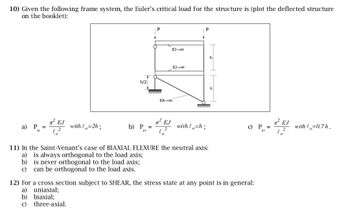Question

Transcribed Image Text:10) Given the following frame system, the Euler's critical load for the structure is (plot the deflected structure
on the booklet):
P
EJ-∞
h
E-∞
T
h/2
EA-00
h
a) P
π² EJ
with Co
EJ
EJ
=2h;
b) P
2
with o=h;
c) P
with l=0.7h.
cr
cr
0
20
11) In the Saint-Venant's case of BIAXIAL FLEXURE the neutral axis:
a) is always orthogonal to the load axis;
b) is never orthogonal to the load axis;
c)
can be orthogonal to the load axis.
12) For a cross section subject to SHEAR, the stress state at any point is in general:
a)
uniaxial;
b) biaxial;
c)
three-axial.
Expert Solution
This question has been solved!
Explore an expertly crafted, step-by-step solution for a thorough understanding of key concepts.
Step by stepSolved in 2 steps

Knowledge Booster
Similar questions
- B8] This question concerns two inertial frames S and S' with origins coinciding at t = t' = 0, and a set of events taking place along the x-axis, which defines the direction of relative motion. -8 a) The coordinates of event A in frame S are x = 12 m and t = 8x10 s. If the coordinates of this event in frame S' are x' = -3 m and t' = 7 x 10- s, show that the y factor for transformations between S and S' is 5/4. b) Events B and C take place in S' at a time t' = 6 × 10-* s at x' = 1 m and x' = 2 m respectively. What is their spatial separation in frame S? %3D -8- c) Event D takes place in S' at t' = 3 x 10 s and x' = 1 m. What is the time difference between events B and D in S? d) Is it possible for events A and D to take place at the same time in the frame of an observer moving along the x-axis?arrow_forwardI Review I Constants I Periodic Table The position of a 55 g oscillating mass is given by T (t) = (1.7 cm) cos 13t, where t is in Part C seconds. Determine the spring constant. Express your answer in newtons per meter. Hνα ΑΣφ ? k = N/m Submit Request Answer Part D Determine the maximum speed. Express your answer in meters per second. Iνα ΑΣφ Umax = m/s Submit Request Answerarrow_forwardFor which of the following bodies the kinetic energy is greater. 1. A 2M mass with a 3V velocity 2. A 3M mass with velocity V 3. A mass M with a velocity 4V 4. They all have the same kinetic energy. 5. A mass of 3M with a velocity 2Varrow_forward
- Suppose that two identical particles with rest mass m and non-zero velocities and respectively in the Lab frame collide to form a single particle with rest mass M. Which one of the following statements is correct? Select one: O a. None of the other answers is correct. O b. Mis equal to the sum of the rest masses of the original particles. O c. Mis less than the sum of the original rest masses. O d. Mis greater than the sum of the original rest masses.arrow_forwardConsider the equation for kinetic energy: KE = 1/2mv^2 = 1/2 * m * v^2. If I ask you to take the derivative of kinetic energy, you should ask "the derivative with respect to what?" a) Suppose mass m is constant. Compute the derivative of KE with respect to v, (d(KE)/dv). b) Who takes derivatives with respect to velocity? No one. Except you, just now. Sorry. The rate of change of energy with respect to time is more important: it is the Power. Now, consider velocity v to be a function of time, v(t). We will rewrite KE showing this time dependance: KE= 1/2 * m * v(t)^2. Show that (d(KE)/dt) = F(t)v(t). Hint: use Newton's second law, F = ma, to simplify. c) In the computation above, we assumed m was constant, and v was changing in time. Think of a physical situation in which both m and v are varying in time. d) Compute the Power when both mass and velocity are changing in time. (First rewrite KE(t) showing time dependence, then compute (d(KE)/dt).arrow_forwardAn electron-positron collider creates muons through the reaction et +e →µ* +µ. In the center-of-momentum frame, what is the minimum speed of the electron for this reaction to occur, in terms of the masses me and mu of the electron and muon? Oc(1-) 2m 7ne - my O This process can occur at any speed.arrow_forward
- 3. -In a reference frame S, two events take place at the same point in space, but the second event occurs 2s after the first. In a reference frame S' , moving with respect to S, the second event occurs 3s after the first.a) What is the velocity of S' relative to S?b) What is the distance between the positions of both events in S'?arrow_forwardElectrons are accelerated to an energy of 13.0 GeV in the 3.00 km long Stanford Linear Accelerator. (a) What is the γ factor for the electrons?(b) What is their speed? Answer to 10 decimal places. c(c) How long does the accelerator appear to them? cmarrow_forward
arrow_back_ios
arrow_forward_ios